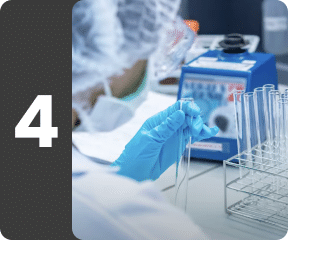Infertility Panel for Men
Understanding Infertility Panel for Men
What is Infertility Panel for Men?
The Infertility Panel for Men includes a set of blood tests that helps evaluate the hormonal factors contributing to infertility in men. The panel includes key tests such as Testosterone (total and free) test to assess androgen levels, Follicle stimulating hormone (FSH), luteinizing hormone (LH) and serum prolactin tests to evaluate the functioning of the testes and pituitary gland as they affect the reproductive health. Additionally, it includes thyroid stimulating hormone (TSH)- ultrasensitive test to assess thyroid function, as thyroid imbalances can impact fertility. This panel helps identify underlying conditions that may be affecting the sperm production, sexual function and overall reproductive health, guiding targeted treatment to improve fertility outcome in men.
What does Infertility Panel for Men measure?
Contains 6 tests
Testosterone Free
The Testosterone Free test measures the level of unattached or free testosterone in the blood. It is called free testosterone or free T because it is not attached to other molecules, especially proteins. The body actively uses free testosterone as signaling molecules that regulate metabolism and other cellular functions.
Know more about Testosterone Free

Follicle Stimulating Hormone
The Follicle Stimulating Hormone test measures the level of FSH in your body. FSH is produced and subsequently released into the blood by the pituitary gland. Its production is controlled by a feedback mechanism involving a hormone situated in the hypothalamus in the brain. The released FSH travels through your blood and then attaches to receptors in the ovaries and testes. It exerts functional effects on the reproductive organs, such as sexual development, puberty, and maturation. FSH levels vary throughout the menstrual cycle in response to estradiol and progesterone. Any disruption or issue in this feedback mechanism can prevent the normal function of the testicles or ovaries. Thus, determining its level provides crucial information regarding your health.
Know more about Follicle Stimulating Hormone

Serum Prolactin
The Serum Prolactin test measures how much prolactin hormone is in the blood. During pregnancy, prolactin works along with estrogen and progesterone to prepare the body for breastfeeding. After delivery, prolactin helps start and maintain milk production. If a woman does not breastfeed, her prolactin levels drop soon after birth.
Besides pregnancy, the most common cause of high prolactin is a prolactinoma. It is a non-cancerous tumor in the pituitary gland. These tumors are more common in women but can also occur in men. If the tumor becomes large, it may press on the optic nerve, causing headaches and vision problems. It can also affect the production of other hormones.
Know more about Serum Prolactin

TSH (Thyroid Stimulating Hormone) Ultrasensitive
The TSH (Thyroid Stimulating Hormone) Ultrasensitive test measures the levels of TSH hormone in the blood. TSH is produced by the pituitary gland located in the brain. Its function is to stimulate and regulate the functioning of the thyroid gland. It signals the thyroid gland to increase or decrease the production of thyroid hormones T3 and T4 when their levels are low or high, respectively. Therefore, when the levels of T3 & T4 decrease, the pituitary gland is stimulated to release TSH. This high TSH level, in turn, stimulates the thyroid gland to release more thyroid hormones (T3 & T4); vice versa happens when the levels of thyroid hormones increase.
Know more about TSH (Thyroid Stimulating Hormone) Ultrasensitive

Luteinising Hormone
The Luteinising Hormone test determines the level of luteinizing hormone that promotes the functioning of the gonads, i.e., testes in men and ovaries in women. LH is produced by the pituitary gland, a pea-sized gland situated at the base of the brain. The production and release of LH are controlled by a system known as the hypothalamic-pituitary-gonadal axis. A hormone called GnRH is released from the hypothalamus of the brain and binds to the cell receptors in the anterior pituitary gland, which in turn prompts the synthesis and release of luteinizing hormone. LH then travels across the blood and attaches to its target cells in the testes in men and ovaries in women to facilitate optimal sexual and reproductive activities.
Know more about Luteinising Hormone

Testosterone Total
The Testosterone Total test measures the level of testosterone hormone available in the blood. This includes two forms of testosterone: free testosterone and bound testosterone. Bound testosterone is attached to proteins, mainly to sex hormone-binding globulin (SHBG) and albumin. It cannot enter the body's cells or directly affect tissues and organs. Instead, it acts as a store of testosterone in the blood and can be released when the body needs it. Free testosterone is not attached to any proteins and is the active form. It can easily transport to various tissues, and affects key functions like sex drive, muscle growth, bone strength, and energy levels.
Know more about Testosterone Total
Book a Infertility Panel for Men test at home near me





Other tests









